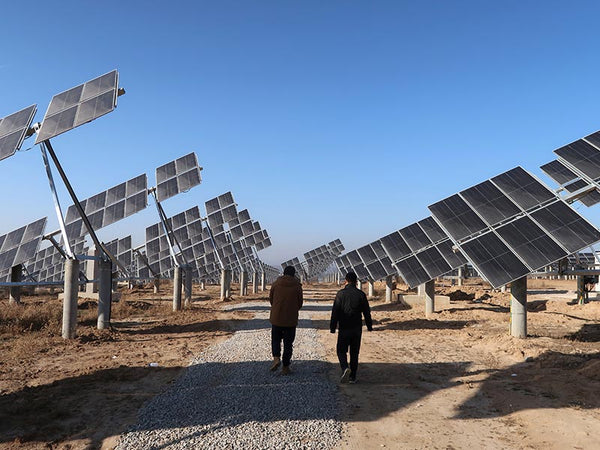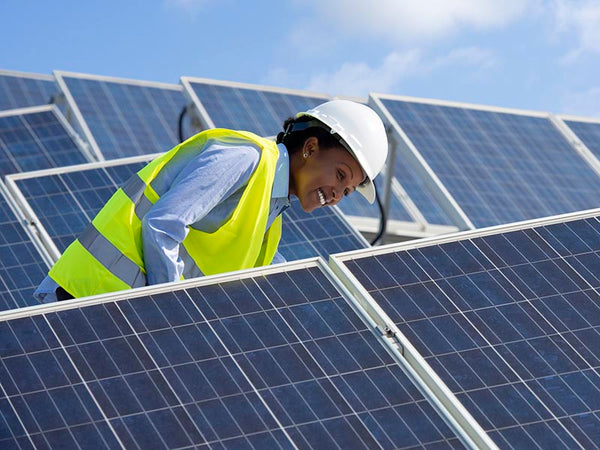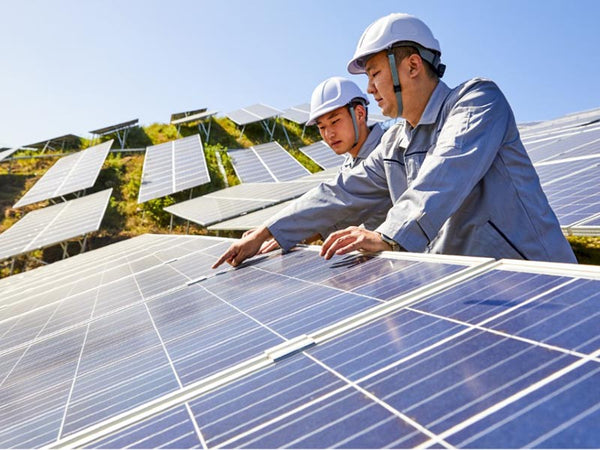
main content:
Modern scientific research shows that the sun is a huge hot air mass, which is mainly composed of hydrogen, ammonia and other elements, of which hydrogen accounts for 78.4%, nitrogen accounts for 9.8%, metals and other elements account for 1.8%; the surface temperature of the sun can be Up to 6000℃, the internal temperature is as high as 10-20 million℃, and the internal pressure is more than 340 billion atmospheric pressure. Under such high temperature and high pressure, the thermal fusion reaction from hydrogen to nitrogen is carried out, which releases a large amount of radiant energy. This reaction can last for a long time, and it is estimated that it can reach tens or even tens of billions of years. Compared with human life, solar energy can be said to be inexhaustible and inexhaustible. The energy that the sun radiates to the earth’s land surface is about 17 trillion kilowatts a year, which accounts for only 10% of the total radiation reaching the outer surface of the earth’s atmosphere. Even so, it is equivalent to the current world energy consumption in one year. 35,000 times the total.
When non-renewable energy sources such as electricity, coal, and oil are frequently urgently needed, and energy issues have increasingly become a bottleneck restricting international social and economic development, more and more countries have begun to implement the "Sunshine Plan" to develop solar energy resources and seek new impetus for economic development. As a renewable new energy source, solar energy has attracted more and more people's attention.
The solar energy received by our planet accounts for only about one-two billionth of the total energy emitted from the surface of the sun, which is equivalent to 30,000-40,000 times the total energy required by the world. Secondly, the universe has no day and night and four seasons, and there are no dark clouds and shadows, and the radiant energy is very stable. Therefore, the power generation system is relatively simpler than the ground, and in a weightless, high-vacuum cosmic environment, the requirements for the strength of the equipment components are not too high. Furthermore, unlike fossil fuels such as petroleum and coal, solar energy will not cause the "greenhouse effect" and global climate change, nor will it cause environmental pollution. Because of this, the use of solar energy has been valued by many countries, and everyone is racing to develop various new optoelectronic technologies and new optoelectronic materials to expand the application fields of solar energy utilization. From power generation, heating, water supply to various solar power devices, its applications are very extensive. In some areas, the use of solar energy has begun to enter the practical stage. Especially in the past 10 years, we are increasingly looking forward to the arrival of the "solar age" under the attack of two major crises, the bottoming out of oil and the deteriorating ecological environment.
1. Status of solar energy utilization and development abroad

From 1974 to 1997, the cost of power generation of silicon semiconductor photovoltaic cells in developed countries such as the United States and Japan was reduced by an order of magnitude: from US$50 per watt to US$5. Since then, most experts from all over the world believe that in order to make solar power plants economically competitive with traditional power plants (mainly thermal power plants), there is still a long way to go to reduce their costs by an order of magnitude. At present, there are many projects built in the United States and other countries that use solar pools to generate electricity. On the banks of the Dead Sea, there is an experimental solar pool of 7000 square meters built in 1979 to heat a 150-kilowatt generator. The United States plans to build 8.3% of its salt lake (approximately 8,000 square kilometers) into a solar pond to provide heat for a 600-megawatt generator set. Experts from the Institute of Radio Physics of Armenia also announced that they have begun construction of its "first small-scale experimental model" industrial solar power station in the mountains of the country. The turbines used in the power station are not new, but turbines removed from the helicopter after their service life has expired. The installed capacity is only 100 kilowatts, but the power generation cost is only 0.5 cents per kilowatt hour, and the efficiency is as high as 40% to 50%.
Russian scholars have also made remarkable progress in solar pond research. A company combined the solar water jet and jet-cooled thruster developed by it with the solar pool project, attached ice troughs and other facilities to the solar pool, and designed a new solar pool suitable for farmers. According to this design, a farmer with 6 to 8 people can build a 70-square-meter solar pool to meet the annual electricity needs of their 100-square-meter house. Another research institution proposed the design idea of a combined solar pool power station, that is, the use of heat pumps, heat pipes and other technologies to comprehensively utilize solar energy, geothermal heat, and room waste heat, so that the cost of solar pool power generation is greatly reduced. Power stations compete and are available all year round. They can be used for air conditioning in summer and heating in winter.
In developed countries, the development and utilization of solar energy has become more extensive and its technology has become increasingly mature. For example, Japan has been actively developing new energy sources such as solar energy for many years. Its solar power generation has been ranked first in the world since 2000. The capacity of Chinese facilities is about 640,000 kilowatts. By 2010, the Japanese government plans to increase the capacity of Chinese facilities by 7 times to reach 4.82 million kilowatts. Israel plans to build a solar power station covering an area of 400 hectares in the Negev Desert, with a designed power generation capacity of 500,000 kilowatts, accounting for about 5% of the country's electricity production. The United States has launched the "1 million rooftop photovoltaic plan", and plans to install photovoltaic power generation systems on 1 million rooftops by 2010, with an installed capacity of 3 million kilowatts. Germany launched the "One Hundred Thousand Solar Roof Plan" in January 1999, arranging a total of 460 million euros in a fiscal budget to fund enterprises and users that develop and utilize solar energy. At present, households installing solar lighting systems account for 0.9% of the total number of German households. Solar lighting systems have also been vigorously promoted in large public buildings. One of the 2006 World Cup football stadiums in Germany was adopted at the Kaiserslautern Football Stadium. Solar lighting equipment.
From this point of view, the era of solar energy that all mankind has dreamed of is actually approaching, including going to space to collect solar energy, transmitting it to the earth, and turning it into electricity to solve the energy crisis facing mankind. With the advancement of science and technology, this is no longer a dream. The world’s first solar power station, built by the US National Aeronautics and Space Administration and the National Department of Energy, will be assembled in space recently and will soon begin to supply electricity to the ground.
2. Current Status of Solar Energy Development and Utilization in China

China is rich in solar energy resources, and the prospects for solar energy utilization are broad. At present, the scale of China's solar energy industry has ranked first in the world, and it is the country with the largest production and use of solar water heaters in the world and an important producer of solar photovoltaic cells. There are two relatively mature solar products in China: solar photovoltaic power generation systems and solar water heating systems.
Currently, Japan, Germany and the United States are among the top countries in the world for photovoltaic power generation. China's photovoltaic power generation industry started in the 1970s and entered a period of steady development in the mid-1990s. The output of solar cells and modules has steadily increased year by year. After more than 30 years of hard work, it has ushered in a new stage of rapid development. Driven by national projects such as the "Bright Project" pilot project and the "Electricity to the Township" project, as well as the global photovoltaic market, China's photovoltaic power generation industry has developed rapidly. By the end of 2007, the cumulative installed capacity of photovoltaic systems nationwide reached 100,000 kilowatts, and more than 50 companies engaged in the production of solar cells, the production capacity of solar cells reached 2.9 million kilowatts, and the annual output of solar cells reached 1188Mw, surpassing Japan and Europe. A complete industrial chain consisting of multiple links from raw material production to photovoltaic system construction has been preliminarily established. In particular, significant progress has been made in the production of polysilicon materials, breaking through the annual dry ton mark and breaking through the bottleneck of solar cell raw material production. It laid the foundation for the large-scale development of photovoltaic power generation in China.

The development process of China's solar water heater industry can be traced back to the late 1970s. After years of development, China's solar water heater industry has formed a relatively complete industrialization system. From raw material processing, water heater product manufacturing to marketing services, comprehensive supporting and coordinated development, both in terms of output value and holdings have become a veritable big country in the production and application of solar water heaters. In 2007, China's solar water heater output increased by about 30%, with an annual output of 23.4 million m² and a total holdings of about 108 million m². In 2007, the sales of solar water heaters in the market were approximately RMB 32 billion and the output value was RMB 100 million. There are more than 20 companies above. The export value of solar water heaters increased by about 28%, about 65 million U.S. dollars, and the products were exported to more than 50 countries and regions including Europe, America, Africa, and Southeast Asia.
From the perspective of energy supply security and clean utilization, countries all over the world are taking the commercial development and utilization of solar energy as an important development trend. The European Union, Japan and the United States have focused on energy supply security after 2030 on renewable energy sources such as solar energy. It is estimated that by 2030, solar power will account for more than 10% of the world's electricity supply, and by 2050 it will reach more than 20%. Large-scale development and utilization will enable solar energy to occupy a place in the entire energy supply.
In recent years, China has attached great importance to the development and utilization of renewable energy.
After the "Renewable Energy Law of the People's Republic of China" was formally promulgated and implemented, it has provided policy and basic legal protection for the development and utilization of solar energy and other renewable energy. The signing of the Kyoto Protocol, the promulgation of environmental protection policies and international commitments have brought opportunities to the solar energy utilization industry; the development of the western region has provided a huge Chinese market for the solar energy utilization industry; the adjustment of China’s energy strategy has caused the government to increase its commitment to renewable energy. The support of energy development, all of which brings great opportunities for the development of China's solar energy utilization industry.
In order to promote the development of the renewable energy industry, in 2005 the National Development and Reform Commission compiled the "Renewable Energy Industry Development Guidance Catalog" to guide relevant departments in formulating support policies and measures, and guide relevant research institutions and enterprises in technology research and development, project demonstration and investment Construction direction. The Ministry of Construction and other departments have also issued policies to support the development and utilization of solar energy. According to the "Notice on Strictly Implementing Energy-Saving Design Standards for New Residential Buildings", the state has launched "City-level Demonstration of Large-scale Application of Renewable Energy in Buildings". Renewable energy sources such as solar energy are widely used in China, and certain subsidies will be given. With the vigorous promotion of national policies, the development and utilization of solar energy has been rapidly developed in many cities. The Beijing 2008 Olympic Games put forward the concept of "Green Olympics, High-tech Olympics, and Humanistic Olympics". The domestic hot water used in the Beijing Olympic Village mainly relies on solar energy, which can be used by 16,000 people during the Olympic Games. The "Bird's Nest Project", the main venue of the Olympic Games, uses solar power for the first time. The total installed capacity of the solar photovoltaic power generation system is 130 kilowatts, which is a good supplement to the power supply of the Olympic venues. The Shanghai Municipal Government launched the "One Hundred Thousand Rooftop Photovoltaic Power Generation Plan" in September 2005. In Wuxi, a 40-kilowatt rooftop grid-connected photovoltaic power generation system has also been implemented. Shenzhen passed the preliminary review of the Ministry of Construction's city-level demonstration of renewable energy building applications (integrated solar energy buildings) in January 2006, and plans to build 3 million square meters of solar energy application demonstration projects in the next five years. In September 2005, Xuzhou took the lead in using solar-powered bus stations in the country, and the platform can save about one thousand kilowatt-hours of electricity a year. In March 2006, China's first solar street light system was put into commercial operation in Zhejiang and so on.
In March 2009, the Ministry of Finance and the Ministry of Housing and Urban-Rural Development jointly issued opinions on the implementation of China's "Solar Roof Plan". Yinchuan, Qingdao and other cities have successively announced that starting from January 1, 2010, new residential buildings below 12 floors will be designed with solar water heating systems and building integrated technology, and equipped with solar water heating systems. Shenzhen will also install solar water heating systems for nearly 8 million square meters of public buildings in the next five years.
In March 2010, the Ministry of Finance issued the "Interim Measures for the Management of Financial Subsidy Funds for the Application of Solar Photovoltaic Buildings", providing subsidies of up to RMB 20 per watt for some photovoltaic buildings that meet the conditions. In July, the Ministry of Finance, the Ministry of Science and Technology, and the National Energy Administration issued the "Notice on the Implementation of the Golden Sun Demonstration Project" to accelerate the industrialization and large-scale development of China's photovoltaic power generation by means of financial subsidies, technological support and market pull. For a 500 MW photovoltaic power generation demonstration project, a subsidy of 50% to 70% of the total investment will be given.















